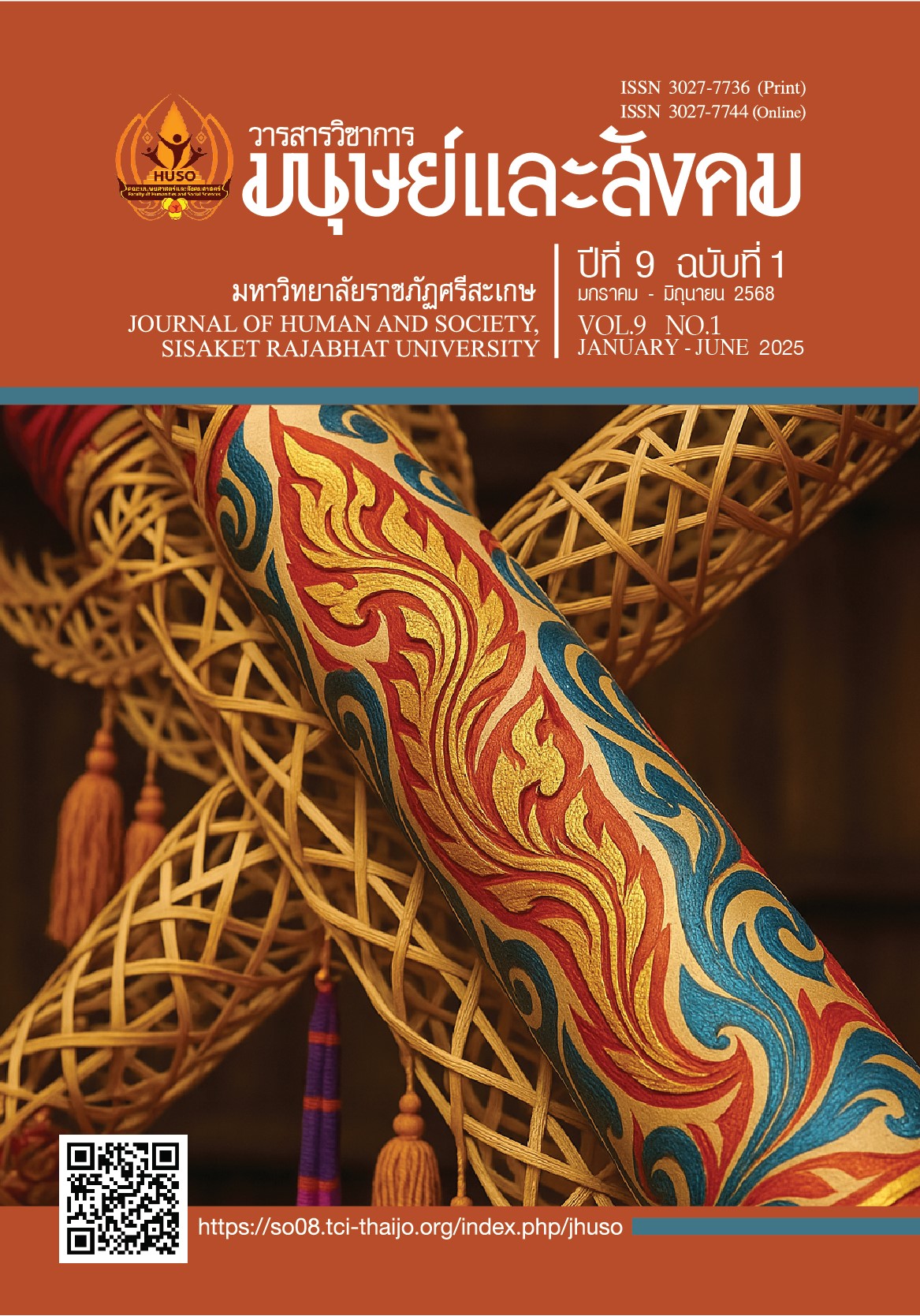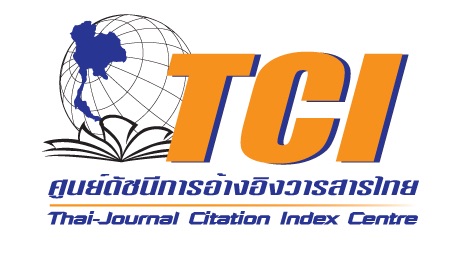The Process of Development Community Market Driving Mechanism for Strengthenning The Community Economy, Taladkhae Subdistrict Municipality, Nonsong District, Nakhonratchasima Province
Keywords:
Community Process, Driving Mechanism, Community Economic, Talad Khae Subdistrict MunicipalityAbstract
This research aimed to: 1) to develop the identity and strategy plan for the community market of Taladkhae Municipality; 2) to analyze stakeholders and their participation in driving the Taladkhae community market; 3) to develop mechanisms and roles in market mobilization; and 4) to synthesize the development process of driving mechanisms to strengthen the community economy of Taladkhae Municipality. This study employed a community-based research (CBR) approach and integrated participatory action research (PAR) techniques. Research tools included focus group discussions, in-depth interviews, document analysis, and participatory workshops. Data were analyzed using causal analysis methods.
The findings revealed that: 1) In the past, the Taladkhae community market was the place for employment and making income for the community due to its location at a three-way junction and function as a rest stop, resulting in a high concentration of shops and services. However, the expansion of the road into four lanes led to a significant decline in market depression. To revitalize the market, its identity was redefined as a “community lifestyle market” focused on safe, affordable, high-quality local products under the brand name "Taladkhae Care Khun." The landscape was redesigned, and a logo featuring the Kae flower was created to reflect the community’s traditional character. A strategic development plan was formulated, encompassing the definition of market vision and identity, the promotion of local products, landscape improvement, and enhancement of the market management system. 2) Stakeholders within the community include community leaders, occupational groups, and local shop owners. External stakeholders include the Taladkhae Municipality, local government agencies, Nakhon Ratchasima Rajabhat University, and passing motorists and travelers. 3) The mechanism of market driving was established through a committee structure with designated roles and responsibilities, including management and operations, procurement and product sourcing, sales, accounting, and advisory teams. 4) The development process of market-driving mechanisms consists of four main components: spatial mechanisms, social mechanisms, economic mechanisms, and external support mechanisms.
References
กรมการพัฒนาชุมชน . (2547). คู่มือองค์กรเครือข่ายกับการบริหารจัดการทุนแบบมืออาชีพ. บริษัทรำไทยเพรส จำกัด.
กรมการพัฒนาชุมชน . (2560). การขับเคลื่อนการพัฒนาเศรษฐกิจฐานรากภายใต้กลไกประชารัฐ. กรมการพัฒนาชุมชน กระทรวงมหาดไทย.
กาญจนา แก้วเทพ. (2527). จิตสำนึกของชาวนา : ทฤษฎีและแนวการวิเคราะห์แบบเศรษฐศาสตร์การเมือง. สมาคมสังคมศาสตร์แห่งประเทศไทย.
กิตติชัย นวลทอง. (2563). ผลงานแนวคิด “ปิ่นโตร้อยสายสร้างเครือข่ายและตลาดชุมชน”. www.pandinthong.com
เกียรติสุดา ศรีสุข. (2548). การวิจัยเชิงปฏิบัติการเพื่อพัฒนาความสามารถในการทำวิจัย. คณะศึกษาศาสตร์ มหาวิทยาลัยเชียงใหม่:เชียงใหม่.
ชุติรัตน์ เจริญสุข, อาคม เจริญสุข และปาริฉัตร วิมูลชาติ. (2556). การวิจัยปฏิบัติการดึงการมีส่วนร่วมเพื่อหาแนวทางการพัฒนาและสร้างความเข้มแข็งให้กับตลาดชุมชนเจ็ดเสมียน อำเภอโพธาราม จังหวัดราชบุรี. มหาวิทยาลัยราชภัฏหมู่บ้านจอมบึง.
ชูพักตร์ สุทธิสา และคณะ. (2554). โครงการวิจัยการพัฒนาระบบและกลไกการพัฒนาคุณภาพงานวิจัยเพื่อท้องถิ่นภาคอีสานสู่การสร้างที่ทางสังคมและการขับเคลื่อนนโยบาย. สำนักงานกองทุนสนับสนุนการวิจัย.
เซอร์กี เคลย์. (2554). พลังกลุ่มไร้สังกัด. มติชน.
ณรงค์ เพ็ชรประเสริฐ. (2542). ธุรกิจชุมชน : เส้นทางที่เป็นไปได้. สำนักงานกองทุนสนับสนุนการวิจัย.
เทศบาลตำบลตลาดแค. (2561). ประชากร. http://www.taladkae.go.th/showdata.
ธงชัย สันติวงษ์. (2540). องค์การและการบริหาร (พิมพ์ครั้งที่ 11). ไทยวัฒนาพาณิช.
สกุล วงษ์กาฬสินธุ์. (2562). ศักยภาพทุนชุมชนในการแก้ไขปัญหาเพื่อพัฒนาหมู่บ้านล้าหลัง อำเภอเสิงสาง จังหวัดนครราชสีมา. มหาวิทยาลัยราชภัฏนครราชสีมา.
สมพันธ์ เตชะอธิกและคณะ. (2547). การเรียนรู้และการจัดการความรู้ขององค์กรชุมชนเพื่อชุมชนเป็นสุข. คณะมนุษยศาสตร์และสังคมศาสตร์ มหาวิทยาลัยขอนแก่น.
สำนักงานคณะกรรมการพัฒนาเศรษฐกิจและสังคมแห่งชาติ. (2559). สรุปแผนพัฒนา เศรษฐกิจและสังคมแห่งชาติ ฉบับที่ 12 พ.ศ. 2560-2564. สำนักงานคณะกรรมการพัฒนาเศรษฐกิจและสังคมแห่งชาติ.
สุภางค์ จันทวานิชม. (2546). วิธีการเก็บข้อมูลในการวิจัยเชิงคุณภาพ. ในคู่มือการวิจัยเชิงคุณภาพเพื่องานพัฒนา,อุทัย ดุลยเกษม (พิมพ์ครั้งที่ 4). สถาบันวิจัยและพัฒนา มหาวิทยาลัยขอนแก่น.
เสริมศักดิ์ ขุนพล. (2557). การศึกษาอัตลักษณ์ทางวัฒนธรรม ความเชื่อของชุมชนเกาะยอ. วารสารปาริชาต มหาวิทยาลัยทักษิณ, 28(3), 83-103.
อัญชัน แกมเชย. (2544). ธุรกิจชุมชนกับสำนึกร่วมในการจัดการป่า กรณีศึกษาบ้านเขา ราวเทียนทอง ตำบลเนินขาม กิ่งอำเภอเนินขาม จังหวัดชัยนาท. วิทยานิพนธ์ มหาวิทยาลัยมหิดล.
อินทรา พงษ์นาค. (2557). อัตลักษณ์ชุมชนเมืองอู่ทองเพื่อพัฒนาการท่องเทียวเชิง วัฒนธรรมจังหวัดสุพรรณบุรี [วิทยานินพนธ์ศิลปะศาสตร์มหาบัณฑิต สาขาการจัดการทางวัฒนธรรม (สหสาขาวิชา)]. จุฬาลงกรณ์มหาวิทยาลัย.
นิรมล ขมหวาน (2557). การศึกษาอัตลักษณ์ของชุมชนตลาดโบราณบางพลี จังหวัด สมุทรปราการ. วารสารอาศรมวัฒนธรรมวลัยลักษณ์, 14(1), 125–144.
Downloads
Published
How to Cite
Issue
Section
License
Copyright (c) 2025 Journal of Human and Society, Sisaket Rajabhat University

This work is licensed under a Creative Commons Attribution-NonCommercial-NoDerivatives 4.0 International License.







